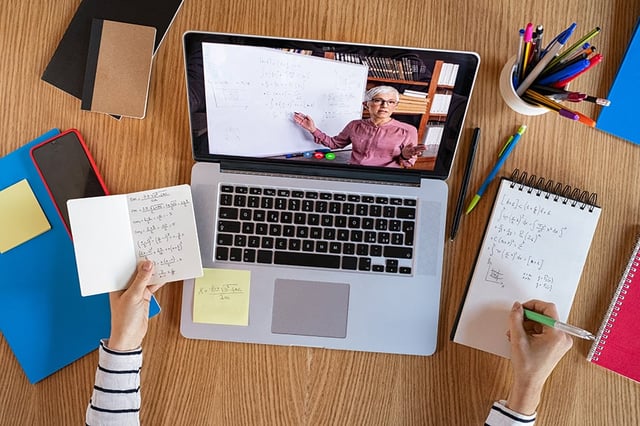Develop a Communication Strategy: Distance Learning Basics Part 2
 Insights By equip team
Insights By equip team
This article was repurposed from our webinar, How to Set Your Class Up for Distance Learning Success, which you can download here.
In this article, we will address strategies for educators as they implement a communication plan to engage students and their parents during distance learning. Strategies featured here are provided by digital communication expert, A. Lee Judge, and eLearning designer, Nicasia Anzalone Caires.
Developing Communication Strategies for Your Distance Learning Environment
“Successful virtual learning is all about relationships.”
In the physical classroom, you’re able to easily interact with students, encourage them as they learn, and communicate to them how you feel. In an online environment, teachers don’t have the benefit of that face-to-face connection.
Here, we’ll take a closer look at communication strategies to bridge the virtual connection to students and parents.
Strategies for Communicating with Students
You have to get creative to cultivate those relationships that make learning successful. It's about students trusting that you're still going to be there for them and that you’ll provide all the materials and all the wonderful directions that you've given in the classroom.
That level of trust is what keeps our students motivated and working in the in this virtual situation that they may or may not be used to at this point in their learning careers.
One-Stop Shop
Keep all information in one location.
Make sure you organize materials just like you would for a lesson – always prepared with everything ready. By keeping these resources in one easily accessible location, you will help yourself as you connect with students and ensure students have what they need to learn.
Even though you're building this plane as you fly it, you do want to make sure that you're still continuing to follow typical teacher practices.
Ready-Made
Take advantage of ready-made content to meet students where they are and consider various modalities.
In addition, there are so many resources already available that can be utilized to introduce and teach concepts. This will help you to save time and find different resources that appeal to different modalities of learning.
Simplify Productivity
Choose simple ways for students to demonstrate learning.
Most importantly, choose simple ways for students to show what they know. Teachers have to consider that many of our students are not accustomed to the demands of online learning, and perhaps their parents are not either, so having a student upload something might be a huge ask for the parent at home.
Instead, ask students to complete a simple exit ticket either in a chat, through an easily accessible online tool that is low lift for them and their parents, or over the phone.
Strategies for Communicating with Parents
Chances are that you still can employ a lot of the same methods you did in a more traditional classroom environment. Parents weren't there every day, but you still communicated with them regularly.
Consistency and Cadence
Keep communication format and timing consistent.
To maintain that relationship with the parents, you want to give them a consistent communication format on a regular schedule. Are you going to do a Monday email and a Friday email or a weekly update? Whatever it is, just keep that consistent.
Scannable Structure
Ensure the communication is easily digestible.
To simplify communication, you want to make sure that the communication method you're using to transmit your information to the students and parents is in a scannable structure. This helps them pull out the most important information and digest it quickly.
Progress Updates
Make it meaningful and preferential.
You also want to make sure that you offer progress updates to parents. Keep those meaningful and keep them preferential.
If a parent does not have the wherewithal to figure out how to you use Zoom, then offer them a phone call, email, text, or whatever it is that you have set up for communication within your district and within your district's policy. It may be something as simple as a global announcement's system.
Be Available
Offer flexible scheduling.
But most importantly, offer a flexible schedule. Parents are still working from home. You're working from home. Students are trying to work from home and be good office mates. So, offer that flexibility for time and method.
Example Communication Methods
To demonstrate these strategies in practice, here are some real-life communication methods educators can and are employing to stay connected with students and parents.
Example Email Communication

This example the actual template Nicasia used during her years as a virtual teacher. She calls it, what's new and what’s due.
Elements
- Clear, identifiable subject
- Brief, warm, positive intro
- What’s New? (announcements)
- What’s Due? (lessons for the week)
- Parent Section
- Contact Section
In addition, you'll notice that at the top that she sends it to herself and blind copies (BCCs) parents and students to protect their emails.
Using this template, she received a lot of positive feedback from parents who appreciated knowing exactly what they were getting each week.Example Padlet Board
Padlet is a great tool to visually curate and organize resources. You can add items and move them around as needed, and you can make the board read only so you are the only one who can edit. It's super intuitive and makes information easily digestible and appealing.
You can upload videos, URLs, documents, images, and other items. It also works on a computer, iPhone, iPad, and Android Kindle.
Here is an example board.

If your district doesn't provide a place to curate all of your information and resources for students, this is a great application. You can even put a link to the Padlet in that email that you send home to parents.
Example Website Communication
For those of you who are use Google Classroom or similar applications, you can also create some form of a website.
This example is from Ms. Jutzi’s google site. She's a kindergarten teacher in the Philadelphia School District in Pennsylvania.

On this page, she curates links to the different websites that students need to complete their work as well as login instructions for the different resources. She also shares instructional tips for parents who may not be used to teaching different subject matter.
As you can see, the simple format makes this easy to read and navigate, and having all the resources in one centralized location eases the lifts on parents and students.
Example High School Communication
For a high school example, this is courtesy of Tammy Berkely at Seminole County Virtual Schools in Florida. She created a canvas site to organize lessons and resources for her students.


You might also consider adding:
- Contact information in prominent locations
- Availability and appointment calendar
- Announcements
- Links to resources
- Due dates and a link to syllabus
 A. Lee Judge is the Co-Founder and CMO of Content Monsta, a digital content agency. He also serves as Global Digital Marketing Manager, at Hexagon Geosystems. Previously, Lee served as Sr. Digital Marketing Director at B2B customer service software company Jacada, connecting the organization’s Sales and Marketing Operations. Focused on B2B marketing for over 20 years, Lee is both a digital marketing practitioner and creative content entrepreneur. He is a leading LinkedIn video creator, Forbes Agency Council member, and engaging event speaker providing training on digital marketing, content creation, social selling, and sales enablement from the Marketing point of view.
A. Lee Judge is the Co-Founder and CMO of Content Monsta, a digital content agency. He also serves as Global Digital Marketing Manager, at Hexagon Geosystems. Previously, Lee served as Sr. Digital Marketing Director at B2B customer service software company Jacada, connecting the organization’s Sales and Marketing Operations. Focused on B2B marketing for over 20 years, Lee is both a digital marketing practitioner and creative content entrepreneur. He is a leading LinkedIn video creator, Forbes Agency Council member, and engaging event speaker providing training on digital marketing, content creation, social selling, and sales enablement from the Marketing point of view.

Nicasia Anzalone Caires is an eLearning Instructional Design Expert & Senior Implementation Specialist at Learning.com.
Nicasia has been an educator and instructional designer for over 20 years and has a passion for using technology to create authentic learning experiences. She labels herself a “lifelong learner." She holds a master’s degree in Elementary Education as well as Instructional Technology, and a Certification in Instructional Design. Nicasia has taught technology in grades K-12, written virtual courses in various learning management systems, and developed and lead district level professional development and technology workshops. Nicasia’s prior school district experience - beyond teaching - is as an Instructional Designer, Online Instructor and Trainer with Seminole County Public Schools, Florida, and a District Distance Learning Coordinator, Instructional Design Coach, and Instructor with Wissahickon School District, Pennsylvania. She has used Learning.com curriculum over the last five years to empower teachers with curriculum that prepares students to be future ready in a competitive and digital world.




